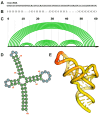The Unpaved Road of Non-Coding RNA Structure-Function Relationships: Current Knowledge, Available Methodologies, and Future Trends
- PMID: 40126344
- PMCID: PMC11932211
- DOI: 10.3390/ncrna11020020
The Unpaved Road of Non-Coding RNA Structure-Function Relationships: Current Knowledge, Available Methodologies, and Future Trends
Abstract
The genomes from complex eukaryotes are enriched in non-coding genes whose transcription products (non-coding RNAs) are involved in the regulation of genomic output at different levels. Non-coding RNA action is predominantly driven by sequence and structural motifs that interact with specific functional partners. Despite the exponential growth in primary RNA sequence data facilitated by next-generation sequencing studies, the availability of tridimensional RNA data is comparatively more limited. The subjacent reasons for this relative lack of information regarding RNA structure are related to the specific chemical nature of RNA molecules and the limitations of the currently available methods for structural characterization of biomolecules. In this review, we describe and analyze the different structural motifs involved in non-coding RNA function and the wet-lab and computational methods used to characterize their structure-function relationships, highlighting the current need for detailed structural studies to explore the molecular determinants of non-coding RNA function.
Keywords: X-ray crystallography; chemical probing; cryo-EM; non-coding RNA; structure–function relationships.
Conflict of interest statement
The authors declare no conflicts of interest.
Figures







Similar articles
-
Towards Molecular Mechanism in Long Non-coding RNAs: Linking Structure and Function.Adv Exp Med Biol. 2022;1363:23-32. doi: 10.1007/978-3-030-92034-0_3. Adv Exp Med Biol. 2022. PMID: 35220564 Review.
-
Getting to the bottom of lncRNA mechanism: structure-function relationships.Mamm Genome. 2022 Jun;33(2):343-353. doi: 10.1007/s00335-021-09924-x. Epub 2021 Oct 12. Mamm Genome. 2022. PMID: 34642784 Free PMC article. Review.
-
Integrated structural biology to unravel molecular mechanisms of protein-RNA recognition.Methods. 2017 Apr 15;118-119:119-136. doi: 10.1016/j.ymeth.2017.03.015. Epub 2017 Mar 16. Methods. 2017. PMID: 28315749 Review.
-
Genome-Wide Approaches for RNA Structure Probing.Adv Exp Med Biol. 2016;907:29-59. doi: 10.1007/978-3-319-29073-7_2. Adv Exp Med Biol. 2016. PMID: 27256381
-
Analysis of genomic variation in non-coding elements using population-scale sequencing data from the 1000 Genomes Project.Nucleic Acids Res. 2011 Sep 1;39(16):7058-76. doi: 10.1093/nar/gkr342. Epub 2011 May 19. Nucleic Acids Res. 2011. PMID: 21596777 Free PMC article.
References
Publication types
LinkOut - more resources
Full Text Sources
Miscellaneous

